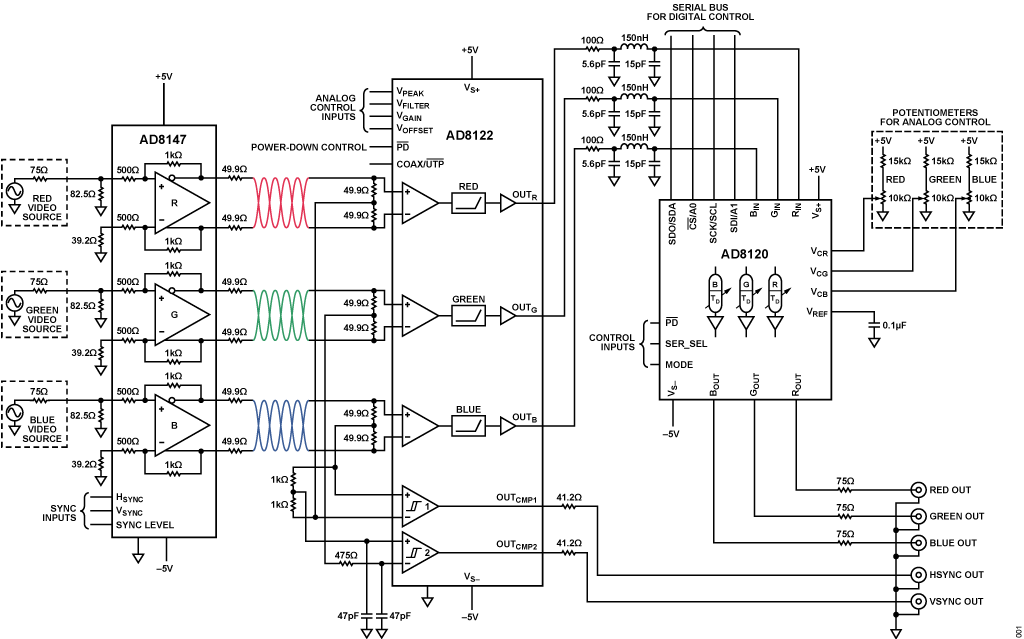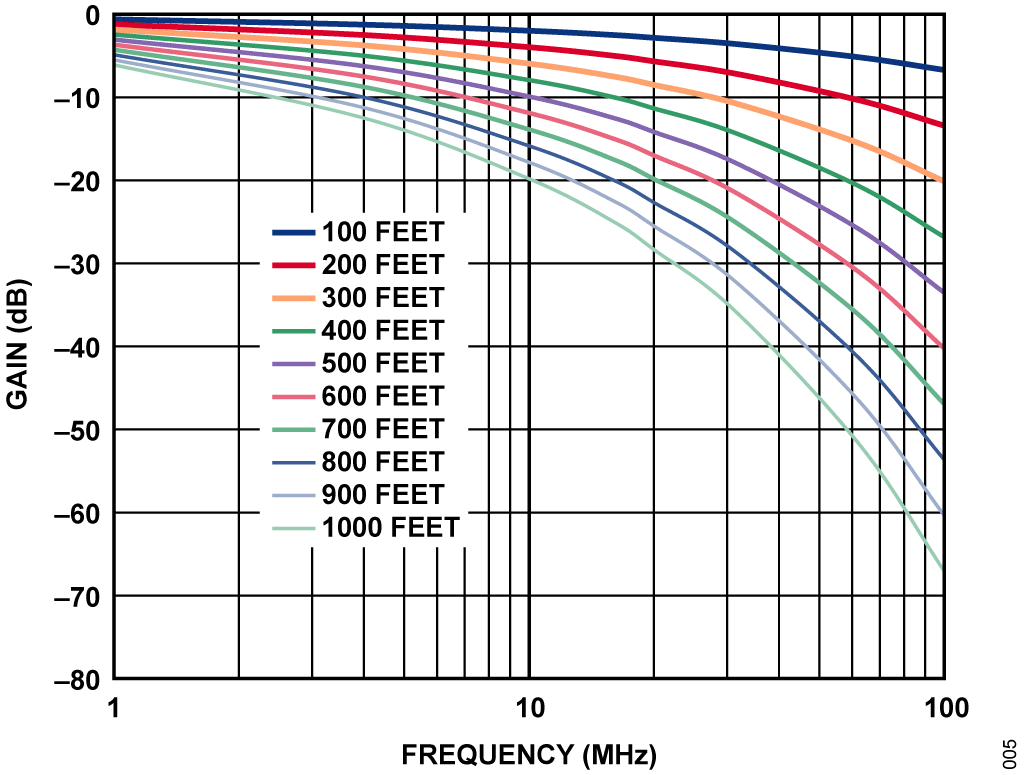AN-2543: 支持通过 UTP 传输视频的完整宽带驱动器和接收器解决方案,针对 RGB、YPbPr 及其他
电路功能与优势
非屏蔽双绞线(UTP)——如 Category-5e(Cat-5e)——最初设计为传输局域网(LAN)流量,现已成为其他许多信号传输应用的经济型解决方案,因为它具有可观的性能和低成本优势。这些应用均为传输宽带视频信号的系统,它们采用 4 对双绞线中的 3 对传输红、绿、蓝(RGB)电脑视频信号或亮度和两个色差(YPbPr)、高清分量视频信号。视频信号消隐间隔中可嵌入所需的水平和垂直同步脉冲,这些脉冲亦可在 3 对双绞线中作为共模差分信号传输。这些系统经常包含视频交叉点开关,并用于将来自少量信号源的视频信号分发至许多显示器(如数字标牌应用),或将来自大量信号源的视频信号分发至几个显示器,如键盘-视频-鼠标(KVM)网络。
通过 UTP 电缆传输的信号主要受三个损害的影响,这些损害会导致视频质量下降:
- 集肤效应造成非线性限带,导致信号消散和高频信号内容丢失。该损害导致图像锐度下降并出现暗条纹。
- 阻性损耗带来低频平坦损耗,造成图像对比度下降。
- 用于尽量减少线对间串扰的对绞率(走线长度)不同,导致 4 对双绞线之间存在延迟偏斜。由于收到的 3 路信号在时间上存在对齐误差,延迟偏斜导致收到的图像出现色彩误差。
图1所示的解决方案通过采用三通道接收器/均衡器 AD8122恢复视频信号的高频内容,同时提供平坦增益,从而克服了这些损害。AD8120三路偏斜补偿模拟延迟线会在两路最先到达的信号中加入延迟,使得三路收到的信号在时间上正确对齐。AD8147三通道驱动器提供视频源信号所需的单端至差分转换。
电路描述
1 所示的视频传输系统采用 RGBHV 视频信号,其中 RGB 表示红、绿、蓝视频信号,HV 表示独立的水平和垂直同步脉冲信号。因此,总共 5 路信号通过 3 对双绞线电缆传输。
视频系统性能以时域描述最为合适,并且最重要的规格是阶跃响应建立时间。视频显示中两个像素之间的转换通常是阶跃函数,且每个像素持续一段特定的时间。理想情况下,视频的阶跃响应会在像素时间的一小部分(对于60 Hz时的UXGA,约为6 ns)内完成建立,并且相对于最终值的误差应小至忽略不计(低于满量程约 46 dB,或 3.5 mV)。虽然某些频域性能指标很重要,但最重要的是这些指标在时域内对视频信号有何影响。例如,系统带宽必须足够高,以产生上升时间短到满足建立时间规格要求的阶跃响应。然而,单有带宽还不够,因为振铃、过冲和响应迟缓,甚至宽系统带宽具有的短上升时间,都可产生极大的建立误差。系统简化框图见图 2。
驱动器
RGB 信号通常源自 75 Ω 单端、源接端电压源,且需要 75 Ω 负载端接。在负载上,正确端接的信号幅度通常在 0 mV 和 700 mV 间变化。为了通过 UTP传输 RGB 信号,信号会从单端模式转换为平衡(差分)模式,然后放大 2 倍以考虑因 UTP 源和负载端接造成的 6 dB 损耗。这可通过使用三通道差分驱动器轻松实现,如 AD8147。
AD8147 根据以下公式提供额外的特性,以编码TTL 逻辑电平、三路输出共模电压(VOCM)上的水平和垂直同步脉冲信号:



其中:
K 表示中间电源电压 (VMIDSUPPLY)与共模脉冲电压的峰值偏差。
VSYNCM 和 HSYNC 是单位加权项,对于逻辑 1 为+1,对
于逻辑 0 为-1。
这种编码方案产生数值为零的净交流共模电压,从而最大程度地减少来自电缆的共模电磁辐射。
驱动器评估板包含实施单端至差分模式转换和同步脉冲编码所需的全部信息,包括 K 的调节。
接收器
UTP 电缆的集肤效应产生随频率增加的传输损耗,导致收到的信号呈现圆形且分散,并且简单电缆电阻导致电缆的平坦阻性损耗。图 3 通过对比 300 米长的 UTP 全摆幅视频阶跃响应与输入电缆的阶跃信号,展示了这些效应。
AD8122 三通道均衡器执行差分至单端模式转换,针对这些信号损害提供高共模抑制和补偿。图 4 显示了均衡器输出端校正后的阶跃信号,建立至 1%误差所需时间少于 70 ns。注意,图 4 中的时间标尺以纳秒为单位。
对于频域而言,图 5 显示了长度为 100 英尺至 1000英尺的 Cat-5e 电缆的频率响应,长度以 100 英尺递增,限带效应和平坦损耗极为明显。
有关 AD8122 如何有效恢复接收信号的高频内容以及平坦损耗,可通过对比图 6 中 AD8122 输出的均衡频率响应和图 5 中的非均衡频率响应看出。对于1000 英尺(300 米)长的电缆,60 MHz 时超过 50 dB的非均衡损耗经 AD8122 均衡器优化后为 3 dB。
针对最后一个损害,AD8120 三路延迟线纠正了 3对双绞线之间的时间偏斜,并提供 2 倍的增益以驱动通过双端接 75 Ω 电缆传输至显示器的视频信号。
接收器评估板包含 AD8122 和 AD8120 以及所需的全部支持电路,包括 5 个电位计以手动调节高频增强、平坦增益和 3 路延迟线。此外,它还提供针对AD8120 的可选串行控制的串行接口。
结论
视频分配系统中远端的图像质量很重要。图像质量由阶跃响应建立时间决定,当与最终值相差约3.5 mV 时,如果该值超过像素时间的某一小部分时,图像质量便开始受影响。图 7 显示了未采用均衡或偏斜校正时,通过 300 米(1000 英尺)Cat-5e电缆接收图像的极端例子。图 7 中的黑色拖尾极为严重,阶跃响应迟缓,而且时间偏斜导致色彩失调。完全校正后的图像见图 8。
常见变化
成本更低的三通道均衡器 AD8124 在仅需驱动最高200 米的 UTP 系统中可替换 AD8122。AD8124 与AD8122 引脚不兼容,且控制功能也有所不同。
驱动器除了 AD8147,还有很多选择。AD8146 提供和 AD8147 相同的功能,但未集成专门的共模同步电路。AD8146 通常用在那些将垂直和水平同步脉冲放置在视频信号消隐间隔中的系统,而非将脉冲置于共模电压上的系统。AD8148 与 AD8147 规格相同,只不过前者的固定增益为 4 而非 2,并且可配置用于预加重,以驱动最高为 100 英尺的 UTP。对于要求功耗更低的系统, AD8133 和 AD8134 可提供与 AD8146 和 AD8147 对应相同的功能,并且功耗更低,但其带宽较低。最后,对于可使用 5 V电源、成本最低的系统,AD8141和 AD8142 CMOS驱动器也许是最佳选择。
UTP 的安装各不相同,可能覆盖较广的区域、通过多个配线架,并且时而没有接地参考。这些情况可能导致与本地接收器接地参考有关的接收共模电压的剧烈波动。在均衡器前端放置一个具有宽共模范围的平坦增益差分接收器,如 AD8143,则可在这些情况下提供最高 21 V 的输入共模范围。
AD8122 和 AD8124 均同时支持同轴电缆与 UTP 电缆。AD8122 可使用引脚绑定为任一模式,而AD8124 利用 VPOLE 控制来修改其频率响应,支持任一电缆类型。







